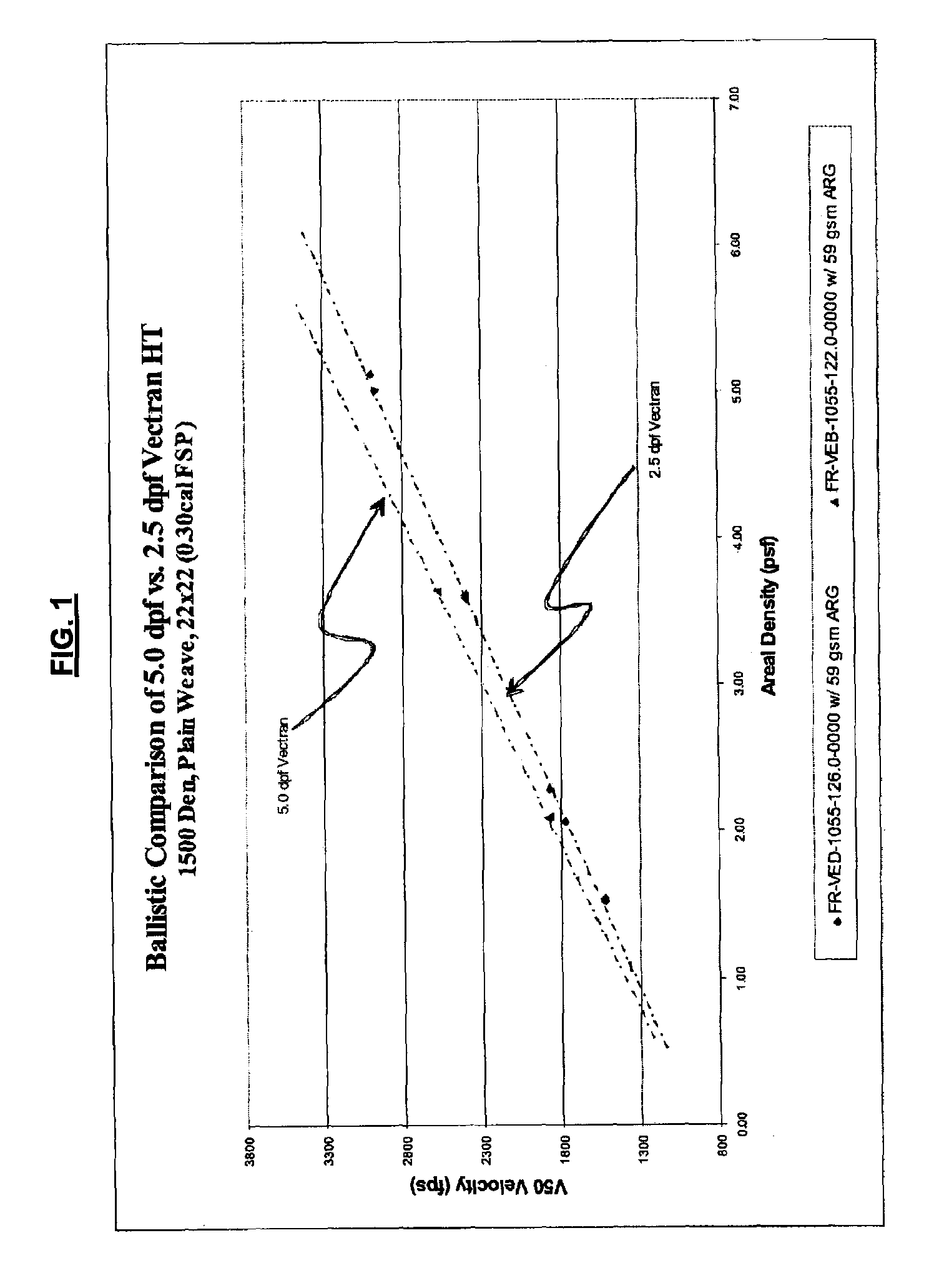Rigid ballistic composites made from poly-para-phenylene terephthalamide fibers having large denier per filament
a poly-para-phenylene terephthalamide and composite technology, applied in the field of ballistic resistance composites, can solve the problems of significantly more expensive armor products, less work on correlating dpf and ballistic performance in rigid armor, and increase the cost of input yarn, so as to achieve the effect of improving ballistic performance and cost reduction
- Summary
- Abstract
- Description
- Claims
- Application Information
AI Technical Summary
Benefits of technology
Problems solved by technology
Method used
Image
Examples
example 1
Effect of DPF on Ballistic Performance of Vectran™ Armor Systems
[0070]In order to do a “head-to-head” comparison of the effect of dpf in rigid armor panels, two substantially identical Vectran® fabrics were woven, one using 2.5 dpf, Vectran HT 1500 denier (600 filament) yarn and one using a 5.0 dpf Vectran 1500 denier (300 filament) yarn produced commercially for only non-ballistic applications. Both Vectran® yarns had similar tensile strengths (of approx 25 g / denier), moduli and % elongations to break. Both were woven in the same 22×22 plain weave construction using a Dornier rapier loom and both greige fabrics had a dry weight of 284 gsm.
[0071]Each fabric was then laminated with the same modified thermoplastic polyethylene ballistic film, having an areal density of 59 gsm, and pressed into ballistic test panels at various areal densities for evaluation. Based on the weight of the film applied, the ballistic test panels all had a DRC (dry resin content) of 17.2%.
[0072]Ballistic lim...
example 2
Effect of DPF on Ballistic Performance of Aramid Armor Systems
[0074]Standard Kevlar® 29, 3000 denier aramid yarn (an assembly of 1333 individual 2.25 dpf yarn filaments), was compared against a lower denier per filament (1.5 dpf, 2000 filament) Kevlar, 3000 denier yarn being introduced by DuPont as a potential direct replacement for the Kevlar® 29 yarn in ballistic applications. The 1.5 dpf Kevlar had the same nominal tenacity (26 g / denier), modulus and elongation to break as the 2.25 dpf Kevlar® 29 yarn.
[0075]3000 denier Kevlar@ 29 yarn is currently used extensively in numerous hard and soft armor applications including military helmets, rigid vehicle armor systems, spall-liners and blast fragmentation blankets. It is the yarn of choice for these applications both due to its performance and its price point vs. lower denier and more expensive Kevlar yarns (e.g. 200, 500, 850 and 1500 denier aramid yarns). These lower denier yarns typically are made from finer dpf yarn filaments.
[007...
example 3
Effect of DPF on Ballistic Performance of Low Density Polyolefin (Innegra®) Armor Systems
[0081]This example investigated whether composites using relatively large dpf yarns of relatively low-density polyolefin, aliphatic (non-aromatic) organic yarns (e.g. UHMWPE, PP, PET, Nylon / Amides) would also exhibit improved ballistic performance compared to similar low dpf composites.
[0082]For this study high modulus polypropylene yarn (i.e. Innegra®) was selected due to the availability of comparable Innegra® yarns of differing denier per filament to test. The inventor believes that it is reasonable to assume that all aliphatic organic yarns would likely show a similar dpf related ballistic performance trend within a certain range of yarn filament diameters and yarn density. The range of viable ballistic yarn filament diameters would be dependent on the density and physical properties of the organic yarn selected (e.g. tensile strength, modulus, and percent elongation to break).
[0083]For this...
PUM
| Property | Measurement | Unit |
|---|---|---|
| elongation to break | aaaaa | aaaaa |
| surface area | aaaaa | aaaaa |
| specific gravity | aaaaa | aaaaa |
Abstract
Description
Claims
Application Information
 Login to View More
Login to View More - R&D
- Intellectual Property
- Life Sciences
- Materials
- Tech Scout
- Unparalleled Data Quality
- Higher Quality Content
- 60% Fewer Hallucinations
Browse by: Latest US Patents, China's latest patents, Technical Efficacy Thesaurus, Application Domain, Technology Topic, Popular Technical Reports.
© 2025 PatSnap. All rights reserved.Legal|Privacy policy|Modern Slavery Act Transparency Statement|Sitemap|About US| Contact US: help@patsnap.com



